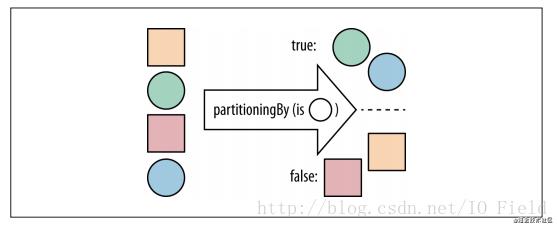Java 8 Lambda 表达式和 Stream 操作
Posted Java-桃子
tags:
篇首语:本文由小常识网(cha138.com)小编为大家整理,主要介绍了Java 8 Lambda 表达式和 Stream 操作相关的知识,希望对你有一定的参考价值。
Lambda表达式的语法
基本语法:
(parameters) -> expression
或
(parameters) ->{ statements; }
复制代码方法引用
方法引用分为三种,方法引用通过一对双冒号:: 来表示,方法引用是一种函数式接口的另一种书写方式
- 静态方法引用,通过类名::静态方法名, 如 Integer::parseInt
- 实例方法引用,通过实例对象::实例方法,如 str::substring
- 也可以类名::实例方法名, 如 String::substring
- 构造方法引用,通过类名::new, 如 User::new
第三点: 若Lambda 的参数列表的第一个参数,是实例方法的调用者,第二个参数(或无参)是实例方法的参数时,格式: 类名::实例方法名
There are several basic function shapes,
including Function (unary function from T to R), Consumer (unary function from T to void), Predicate (unary function from T to boolean), and Supplier (nullary function to R).
Function shapes have a natural arity based on how they are most commonly used. The basic shapes can be modified by an arity prefix to indicate a different arity, such as BiFunction (binary function from T and U to R).
类名::方法名,相当于对这个方法闭包的引用,类似js中的一个function。比如:
public static void main(String[] args) {
Consumer<String> printStrConsumer = DoubleColon::printStr;
printStrConsumer.accept("printStrConsumer");
Consumer<DoubleColon> toUpperConsumer = DoubleColon::toUpper;
toUpperConsumer.accept(new DoubleColon());
BiConsumer<DoubleColon,String> toLowerConsumer = DoubleColon::toLower;
toLowerConsumer.accept(new DoubleColon(),"toLowerConsumer");
BiFunction<DoubleColon,String,Integer> toIntFunction = DoubleColon::toInt;
int i = toIntFunction.apply(new DoubleColon(),"toInt");
}
static class DoubleColon {
public static void printStr(String str) {
System.out.println("printStr : " + str);
}
public void toUpper(){
System.out.println("toUpper : " + this.toString());
}
public void toLower(String str){
System.out.println("toLower : " + str);
}
public int toInt(String str){
System.out.println("toInt : " + str);
return 1;
}
}
复制代码用::提取的函数,最主要的区别在于静态与非静态方法,非静态方法比静态方法多一个参数,就是被调用的实例。
// 使用双冒号::来构造非静态函数引用
String content = "Hello JDK8";
// public String substring(int beginIndex)
// 写法一: 对象::非静态方法
Function<Integer, String> func = content::substring;
String result = func.apply(1);
System.out.println(result);
// 写法二:
IntFunction<String> intFunc = content::substring;
result = intFunc.apply(1);
System.out.println(result);
// 写法三: String::非静态方法
BiFunction<String,Integer,String> lala = String::substring;
String s = lala.apply(content, 1);
System.out.println(s);
// public String toUpperCase()
// 写法一: 函数引用也是一种函数式接口,所以也可以将函数引用作为方法的参数
Function<String, String> func2 = String::toUpperCase;
result = func2.apply("lalala");
System.out.println(result);
// 写法二: 可以改写成Supplier: 入参void, 返回值String
Supplier<String> supplier = "alalal"::toUpperCase;
result = supplier.get();
System.out.println(result);
复制代码数组引用
// 传统Lambda实现
IntFunction<int[]> function = (i) -> new int[i];
int[] apply = function.apply(5);
System.out.println(apply.length); // 5
// 数组类型引用实现
function = int[]::new;
apply = function.apply(10);
System.out.println(apply.length); // 10
复制代码Optional的用法
c static void main(String[] args) {
// Optional类已经成为Java 8类库的一部分,在Guava中早就有了,可能Oracle是直接拿来使用了
// Optional用来解决空指针异常,使代码更加严谨,防止因为空指针NullPointerException对代码造成影响
String msg = "hello";
Optional<String> optional = Optional.of(msg);
// 判断是否有值,不为空
boolean present = optional.isPresent();
// 如果有值,则返回值,如果等于空则抛异常
String value = optional.get();
// 如果为空,返回else指定的值
String hi = optional.orElse("hi");
// 如果值不为空,就执行Lambda表达式
optional.ifPresent(opt -> System.out.println(opt));
复制代码Stream的一些操作
有些Stream可以转成集合,比如前面提到toList,生成了java.util.List 类的实例。当然了,还有还有toSet和toCollection,分别生成 Set和Collection 类的实例。
final List<String> list = Arrays.asList("jack", "mary", "lucy");
// 过滤 + 输出
System.out.println("过滤 + 输出: ");
Stream<String> stream = list.stream();
stream.filter(item -> !item.equals("zhangsan"))
.filter(item -> !item.equals("wangwu"))
.forEach(item -> System.out.println(item));
// 限制为2
System.out.println("limit(2): ");
list.stream().limit(2).forEach(System.out::println);
// 排序
System.out.println("排序: ");
list.stream().sorted((o1, o2) -> o1.compareTo(o2)).forEach(System.out::println);
// 取出最大值
System.out.println("max: ");
String result = list.stream().max((o1, o2) -> o1.compareTo(o2)).orElse("error");
System.out.println(result);
// toList
System.out.println("toList: ");
List<Integer> collectList = Stream.of(1, 2, 3, 4)
.collect(Collectors.toList());
System.out.println("collectList: " + collectList);
// 打印结果
// collectList: [1, 2, 3, 4]
// toSet
System.out.println("toSet: ");
Set<Integer> collectSet = Stream.of(1, 2, 3, 4)
.collect(Collectors.toSet());
System.out.println("collectSet: " + collectSet);
// 打印结果
// collectSet: [1, 2, 3, 4]
复制代码list 转 map(通过 stream)
List<Person> list = new ArrayList<>();
list.add(new Person(1, "mary"));
list.add(new Person(2, "lucy"));
Map<Integer, Person> map = list.stream().collect(Collectors.toMap(Person::getId, Function.identity()));
System.out.println(map);
// 输出: {1=Main3$Person@42f30e0a, 2=Main3$Person@24273305}
Map<Integer, String> map2 = list.stream().collect(Collectors.toMap(Person::getId, Person::getName));
System.out.println(map2);
// 输出: {1=mary, 2=lucy}
复制代码分割数据块

Map<Boolean, List<Integer>> map = Stream.of(1, 2, 3, 4)
.collect(Collectors.partitioningBy(item -> item > 2));
System.out.println(map);
// 输出: {false=[1, 2], true=[3, 4]}
复制代码函数的返回值只能将数据分为两组也就是ture和false两组数据。
数据块分组
数据分组是一种更自然的分割数据操作, 与将数据分成true和false两部分不同,可以使用任意值对数据分组。

groupingBy是都集合进行分组,分组之后的结果形如Map<key,List>。其中,key是进行分组的字段类型,比如按Ussr类中的type(用户类型:1、2、3、4)进行分组,type的类型为Integer,分组之后的Map的key类型就是Integer。并且最多会分成四组,所以最后的结果即Map<Integer,List>。 假设我们想用户类型为1的集合,首先先进行分组,如: Map<Integer,List<User>> userMap = allUserList.parallelStream().collect(Collectors.groupingBy(User::getType)); 接下来直接从Map中get(1)即可,如: List<User> userList = userMap.get(1);
groupingBy与partitioningBy之间的坑
1.必须要提的一点是:在进行get时,groupingBy分组若key不存在则返回null,partitioningBy则会返回空数组,groupingBy分组注意判空。
2.stream处理集合的效率并不一定比迭代器高,如果不要求顺序可以使用parallelStream进行并行流的处理。
字符串
在Java 1.8中,我们可以使用Stream来实现。这里我们将使用 Collectors.joining 收集Stream中的值,该方法可以方便地将Stream得到一个字符串。joining函数接受三个参数,分别表示允(用以分隔元素)、前缀和后缀。
String strJoin = Stream.of("1", "2", "3", "4")
.collect(Collectors.joining(",", "[", "]"));
System.out.println("strJoin: " + strJoin);
// 打印结果
// strJoin: [1,2,3,4]
复制代码以上是关于Java 8 Lambda 表达式和 Stream 操作的主要内容,如果未能解决你的问题,请参考以下文章
Java高阶进阶之Java函数式编程-Stream流-Lambda表达式
Java高阶进阶之Java函数式编程-Stream流-Lambda表达式
JavaSE | Lambda| Optional| Stream API
Java8 新特性 -- Lambda表达式:函数式接口方法的默认实现和静态方法方法引用注解类型推测Optional类Stream类调用JavaScriptBase64